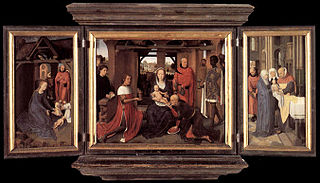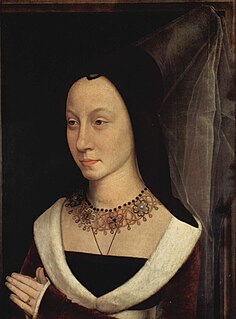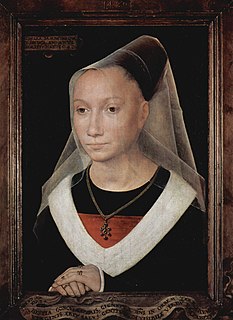 W
WThe Adoration of the Magi is an oil on panel triptych by Hans Memling, painted in 1479–1480, though Max Jakob Friedländer places it in 1470. It is now in the Prado Museum in Madrid, which acquired it in 1847. It is also known as the Prado Triptych.
 W
WThe Adriaan Reins Altarpiece is a three-panel 1480 altarpiece, painted by Hans Memling for brother Adriaan Reins of the Old St. John's Hospital in Bruges. It still hangs there as part of the collection of the Memlingmuseum.
 W
WAdvent and Triumph of Christ is an oil painting on a panel of wood, painted c.1480 by German-born Early Netherlandish painter Hans Memling. It was made for the altar of the Tanners' guild in Our Lady's Church in Bruges, but is now held by the Alte Pinakothek in Munich. It measures 81 × 189 cm.
 W
WThe Annunciation is an oil painting on oak panel attributed to Early Netherlandish painter Hans Memling. It depicts the Annunciation, the archangel Gabriel's announcement to the Virgin Mary that she would conceive and become the mother of Jesus, described in the Gospel of Luke. The painting was completed c. 1482 and was partially transferred to canvas in the 1920s; it is today held in the Robert Lehman collection of the Metropolitan Museum of Art in New York.
 W
WBathsheba are names given to a c 1480 oil on wood panel painting by the Early Netherlandish artist Hans Memling, now in the Staatsgalerie, Stuttgart. Its unusually close framing and the fact that many of the details are cut off suggests that it is a fragment of a larger, probably religious, panel or triptych that was broken up. The painting is noted for being a rare 15th century depiction of a nude person in Northern Renaissance art; such figures typically only appeared in representations of the Last Judgement, and were hardly as deliberately erotic. Memling is attributed one other secular nude portrait, in the center panel of his c. 1485 Vanitas allegory Triptych of Earthly Vanity and Divine Salvation, at the Musée des Beaux-Arts, Strasbourg. As opposed to Bathsheba, that nude is fully exposed, with visible genitalia.
 W
WThe Benedetto Portinari Triptych is a group of three 1487 oil on panel paintings by Hans Memling. It is named after its commissioner, who is probably the subject of its right-hand panel, now in the Uffizi in Florence. The left panel of Saint Benedict and the central panel of the Madonna and Child are both now in the Gemäldegalerie, Berlin. All three panels are set within a single loggia, with a unified landscape background across all three, which proved a major influence on Umbrian painters, Perugino and Leonardo da Vinci.
 W
WChrist Surrounded by Singing and Music-making Angels or Santa María la Real de Nájera Altarpiece, is a triptych by the Flemish painter of German origin Hans Memling, active in Bruges in the second half of fifteenth century. The altarpiece was commissioned by wealthy Spanish traders as the high altarpiece for the monastic church of Santa Maria la Real in Nájera. Only three panels of the original altarpiece survive. In the nineteenth century they were acquired by the Royal Museum of Fine Arts of Antwerp, where they are now exhibited. These panels have been described as an avant-garde work in Renaissance decorative art.
 W
WThe Diptych of an elderly couple is a pair of bust-length wedding portraits by Hans Memling, which were formerly attached with pegs and were split some time before they were sold separately in 1894. One is in the collection of the Gemäldegalerie and the other is in the collection of the Louvre. When viewed side-by-side the landscape background joins up to form a whole.
 W
WThe Diptych of Maarten van Nieuwenhove is a 1487 painting by Hans Memling, showing on the left side the Virgin and Child, and on the right side Maarten van Nieuwenhove. It is now kept in the Old St. John's Hospital in Bruges. It is unsigned, but has invariably been attributed to Hans Memling since the middle of the 19th century.
 W
WThe Donne Triptych is a hinged-triptych altarpiece by the Early Netherlandish painter Hans Memling. It consists of five individual panel paintings: a central inner panel, and two double-sided wings. It was painted for Sir John Donne, probably sometime between the late 1470s or early 1480s, and is in the permanent collection of the National Gallery, London, with the panels still in their original frames.
 W
WEarthly Vanity and Divine Salvation is a 1480s painting by the German-born citizen of Bruges, Hans Memling. It is on display in the Musée des Beaux-Arts of Strasbourg, France. Its inventory number is 185.
 W
WThe Jan Floreins Altarpiece or Triptych of Jan Floreins is a 1479 three-panel altarpiece, painted by Hans Memling for brother Jan Floreins of the Oud Sint-Janshospitaal in Bruges, where it still hangs as part of the collection of the Memlingmuseum.
 W
WThe Last Judgment is a triptych attributed to Flemish painter Hans Memling and painted between 1467 and 1471. It is now in the National Museum in Gdańsk in Poland. It was commissioned by Angelo Tani, an agent of the Medici at Bruges, but was captured at sea by Paul Beneke, a privateer from Danzig. A lengthy lawsuit against the Hanseatic League demanded its return to Italy. It was placed in the Basilica of the Assumption but in the 20th century it was moved to its present location.
 W
WThe Moreel Triptych is the name given to a 1484 panel painting by the Early Netherlandish painter Hans Memling. It was commissioned by the prominent Bruges politician, merchant and banker Willem Moreel and his wife Barbara van Vlaenderberch, née van Hertsvelde. It was intended as their epitaph at the chapel of the St. James's Church, Bruges, an extension they paid for, to the funerary church of Willem's family, where the couple intended to be interred in an underground tomb before the altar.
 W
WThe Mystic Marriage of St. Catherine is a c. 1480 oil-on-oak painting by the Early Netherlandish painter Hans Memling, now in the Metropolitan Museum of Art, New York. The panel shows an enthroned Virgin holding the Child. St Catherine of Alexandria and St Barbara are seated alongside. Angels playing instruments flank the throne, while the male figure to left is presumably the person who commissioned it as a devotional donor portrait.
 W
WPortrait of a Man is a circa 1470 oil on panel painting by Hans Memling. It is now in the Frick Collection in New York, which it entered in 1968 via the Duveen art dealership.
 W
WPortrait of a Man in a Red Hat is an 1465-1470 oil on oak panel painting by Hans Memling, one of the first portraits he produced in Bruges, with similarities to his Portrait of a Man - its subject is unknown. It has some similarities to portraits by Jan van Eyck and Rogier van der Weyden, though the fictive stone frame is Memling's invention.
 W
WThe Portrait of a Man with a Roman Medal is a painting by the German-born Flemish artist Hans Memling, dating to c. 1480 and housed in the Royal Museum of Fine Arts, Antwerp, Belgium.
 W
WPortrait of an Old Woman is a small oil on wood panel painting by the Early Netherlandish painter Hans Memling, completed c 1475–80, and in the collection of the Museum of Fine Arts, Houston, Texas, since 1944. The panel has obviously been cut down given its tight framing. The woman's face and headdress dominate the remaining pictorial space; they create a strong contrast between her cream headgear and the black background and the lower portion of the painting, which was originally bluish green, but has darkened with age and accumulated dirt. Yet the panel is in good condition following a restoration that replaced lost paint in several areas.
 W
WPortrait of Barbara van Vlaendenbergh is small c 1470–72 oil on wood painting by Hans Memling in the Royal Museums of Fine Arts of Belgium. She is shown in three quarters profile with her hands clasped in prayer, and wears a small black hennin with a transparent veil. Her hair is tightly pulled back, and shaved above the forehead. Van Vlaendenbergh is positioned before a landscape framed by an open window.
 W
WThe Portrait of Folco Portinari is a painting by the German painter Hans Memling, dating to c. 1490. It is displayed in the Uffizi Gallery of Florence, Italy.
 W
WPortrait of Maria Portinari is a small c. 1470–72 painting by Hans Memling in tempera and oil on oak panel. It portrays Maria Maddalena Baroncelli, about whom very little is known. She is about 14 years old, and depicted shortly before her wedding to the Italian banker Tommaso Portinari. Maria is dressed in the height of late fifteenth-century fashion, with a long black hennin with a transparent veil and an elaborate jewel-studded necklace. Her headdress is similar and necklace identical to those in her depiction in Hugo van der Goes's later Portinari Altarpiece, a painting that may have been partly based on Memling's portrait.
 W
WPortrait of Tommaso Portinari by Hans Memling is held by the Metropolitan Museum of Art, New York City. It was made c.1470 in oil on oak panel, and measures 44.1 by 33.7 centimetres. The painting and Memling's Portrait of Maria Portinari form the wings from a since dismantled triptych; the central panel is believed to have been a now lost depiction of the Madonna and Child; perhaps Memling's Virgin and Child in the National Gallery, London.
 W
WThe St John Altarpiece is a large oil-on-oak hinged-triptych altarpiece completed around 1479 by the Early Netherlandish master painter Hans Memling. It was commissioned in the mid-1470s in Bruges for the Old St. John's Hospital (Sint-Janshospitaal) during the building of a new apse. It is signed and dated 1479 on the original frame – its date of installation – and is today at the hospital in the Memling museum.
 W
WScenes from the Passion of Christ is an oil painting on a panel of Baltic oak, painted c.1470 by German-born Early Netherlandish painter Hans Memling. The painting shows 23 vignettes of the Life of Christ combined in one narrative composition without a central dominating scene: 19 episodes from the Passion of Christ, the Resurrection, and 3 later appearances of the risen Christ. The painting was commissioned by Tommaso Portinari, an Italian banker based in Bruges, who is depicted in a donor portrait kneeling and praying in the lower left corner, with his wife, Maria Baroncelli, in a similar attitude in the lower right corner.
 W
WSibylla Sambetha is a small oil on oak panel painting by Hans Memling, completed in 1480 and still in its original frame. It is now in the Hans Memling museum at the Old St. John's Hospital in Bruges and shows a young woman who is not pretty, but nonetheless elegant and well dressed. She is set against a black background and looks out of the picture as if she is at a window. Her hands are folded and rest on the lower border of the brown marbled frame, in an early and effective example of trompe-l'œil.
 W
WThe Shrine of St. Ursula is a carved and gilded wooden reliquary containing oil on panel inserts by Hans Memling. Dating to c. 1489, it is housed in the Hans Memling Museum in the Old St. John's Hospital (Sint-Janshospitaal), Bruges in the Flemish Region of modern-day Belgium.